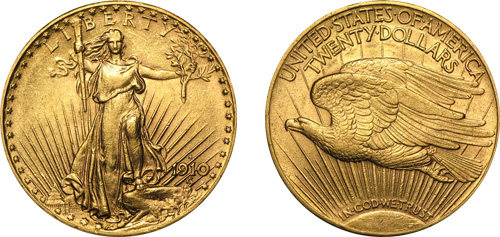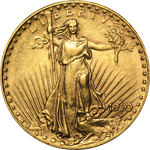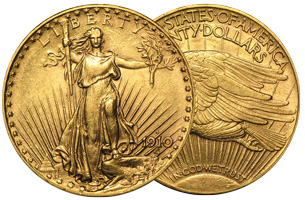The Saint-Gaudens double eagle is a twenty-dollar gold coin that was struck by the U.S. Mint from 1907 to 1933. The coin was named after its designer, sculptor Augustus Saint-Gaudens. The issuance of the coin was a result of a monetary initiative introduced by President Theodore Roosevelt to beautify American coinage. The Saint-Gaudens gold double eagle was minted in Philadelphia, Denver, and San Francisco. It is considered the most beautiful U.S. coin and is known as Saint-Gaudens most famous artwork.
The twenty-dollar double eagle gold piece was first struck in 1850, as a result of the California Gold Rush. The first double eagle coin was the Liberty Head, which was struck throughout the 19th century. Due to its comparatively high face value (today’s equivalent would be several hundred dollars), the coin did not circulate widely other than in the Western states. Saint-Gaudens became associated with the U.S. Mint in the late 19th century, and was asked by Roosevelt in 1904 to design aesthetically pleasing U.S. coins.
Saint-Gaudens sought to craft a coin in high relief because he deemed them more artistic and Roosevelt agreed. However, Secretary of the Treasury, Leslie Mortier Shaw, and Mint Director George E. Roberts were not pleased with that decision and pointed out that striking coins in high relief is much more problematic than producing them in low relief. The Mint first produced 24 experimental dies as patterns; they are known as the “Ultra High Relief” or “Extra High Relief” pieces – there are only about 20 available today and one sold for $2,990,000. A second and a third set were produced while Saint-Gaudens died in 1907. A revised low relief version was finally produced in late 1907 (the modifications were denounced by Saint-Gauden’s family and his assistant Henry Hering).

In the final design, the obverse side features Liberty striding across a rocky outcrop toward the viewer before the dawn of the new day. The sculptor’s major inspiration for the female figure was the ancient marble sculptures Nike of Samothrace. Liberty (representing victory) holds up a torch (representing enlightenment), in her right hand and an olive branch (representing peace) in her left. In the background, one can see sunrays and the Capitol in the lower left. The obverse side also features the engraving “LIBERTY,” the mint year, as well as 46 stars indicating the Union states in 1907 that run along the coins border. The reverse design shows the side view of a flying eagle with the sun and its rays in the background. Moreover, it features the inscriptions “UNITED STATES OF AMERICA” and “TWENTY DOLLARS” on the top, as well as “IN GOD WE TRUST” on the bottom. The edge of the coin bears the lettering “E PLURIBUS UNUM.”
The Saint-Gaudens double eagle contains 90% gold and 10% copper.
Even though Roosevelt specifically stated he did not want to put “IN GOD WE TRUST’ on the coins as he thought it would debase God’s name, Mint Engraver Charles E. Barber added the motto because Congress was outraged about its omission. In 1912, two more stars were added, representing the newly admitted states New Mexico and Arizona. In 1916, the U.S. Mint ceased production of the double eagle as bullion prices were rising due to World War I. Minting was resumed again in 1920, but the double eagle rarely circulated in the U.S. and was rather traded internationally.
In 1933, President Franklin D. Roosevelt ordered the Treasury not to pay out gold anymore and requested that the banks hand over their gold to the Federal Reserve Bank. Numismatists and coin dealers were still allowed to keep and trade coins. By the end of the year, Acting Secretary of the Treasury Henry Morgenthau ordered Americans to turn in all gold coins and gold certificates in exchange for paper money. That year, the last double eagles were minted and all coins were melted in the following years with the exception of a couple of thousand. Two 1933 double eagles were sent by the Mint to the Smithsonian Institution for the National Coin Collection, where they remain today.
By the early 1940s, between 8 and 10 1933 double eagle specimens were known to still exist. In the following years, the Secret Service seized a number of them, which were then melted. Yet, one piece was obtained by King Farouk of Egypt; the “Farouk specimen” later resurfaced in the late 1990s and was subsequently seized by U.S. authorities. The coin sold at auction by Sotheby’s for $7,590,020 (which was equally divided between the U.S. government and the private owns). In 2004, further 10 specimens of the 1933 double eagle surfaced and were submitted to the U.S. Mint for authentication by the heirs of a Philadelphia jeweler. The Mint authenticated them and seized them, which resulted in an ongoing lawsuit.


